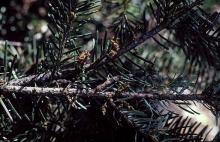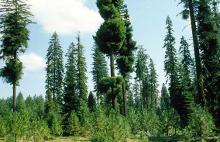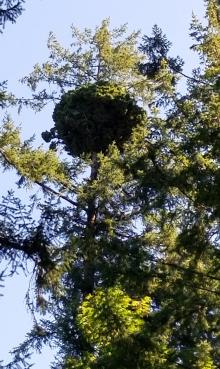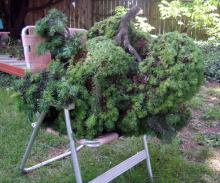See:
Oak (Quercus spp.) - Mistletoe (a True Mistletoe)
Cause Several Arceuthobium spp., parasitic plants, attack important forest species in the PNW. Dwarf mistletoe is an important disease of Douglas-fir (attacked by Arceuthobium douglasii) in southern and eastern Oregon. Arceuthobium douglasii has also been found occasionally on Pacific silver fir and rarely on grand fir and subalpine fir. These mistletoes do not attack oak or other hardwoods.
Dwarf mistletoe also attacks true firs. A. abietinum f. sp. concoloris infects mostly grand fir and rarely Pacific fir and subalpine fir. It has been found east of the Cascade Range and in southwest Oregon but rarely in the Willamette Valley. A. tsugense ssp. amabilae infects noble fir, Pacific fir, mountain hemlock and subalpine fir; occasionally western hemlock and rarely grand fir and western white pine. It has been found on the Cascade Crest from Mt. Hood to the Umpqua River.
Dwarf mistletoes can also be found on ponderosa pine (attacked by A. campylopodum), lodgepole pine (attacked by A. americanum), and western hemlock (attacked by A. tsugense) in much of their native ranges. Western larch can be seriously damaged by A. laricis east of the Cascade Range in the Blue and Wallowa Mountains.
Fruit explodes when mature, dispersing seeds several feet away. Needles of the host tree intercept seeds. Rain then washes seeds down to twigs where germination and penetration occur. Once infection is established, there is an incubation period of 2 to 5 years before young shoots appear. A swelling at the point of infection usually precedes shoot production by a year or more. Pollen from male plants fertilize flowers on female plants, which produce the fruit after several months' development.
They retard the growth of infected trees and cause extensive timber losses through direct and indirect mortality. Host seed production and wood quality can also be reduced. Decay fungi may gain entrance at the site of the mistletoe attachment.
Symptoms Small (0.75 to 4 inches) yellowish-green plants growing in clusters on branches. In Douglas-fir, mistletoe plants appear scattered along slender branches of usually dense, large brooms. However, only one mistletoe plant may be present since its aerial shoots arise from an internal systemic infection. In other tree species, plant clusters arise from spindle-shaped swellings. Witches' brooms of great variety form on all hosts.
Occasionally large brooms may form on Douglas-fir with no apparent cause. Large growths of shortened shoots occur in a dense cluster on branches.
Cultural control
- Remove all plants by harvesting or pruning. This is easiest in mid- or late summer when plants are most easily seen. Aerial shoots will re-grow unless the entire host branch is removed.
- Forestry:
- Clear-cut severely infected stands.
- Remove infested overstory if a manageable susceptible understory is present.
- Favor non-hosts in mixed stands.
References Hawksworth, F.W. and Wiens, D. 1996. Dwarf Mistletoes: Biology, Pathology and Systematics. Agricultural Handbook 709. Washington, DC: USDA Forest Service.
Buckland, D. C., and Kuijt, J. 1957. Unexplained brooming of Douglas-fir and other conifers in British Columbia and Alberta. Forest Science 3:236-242.





